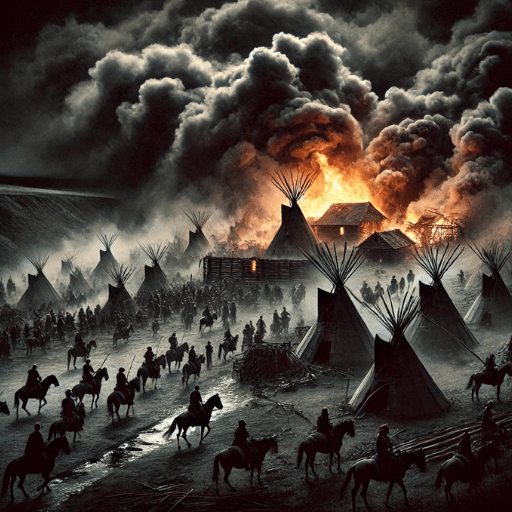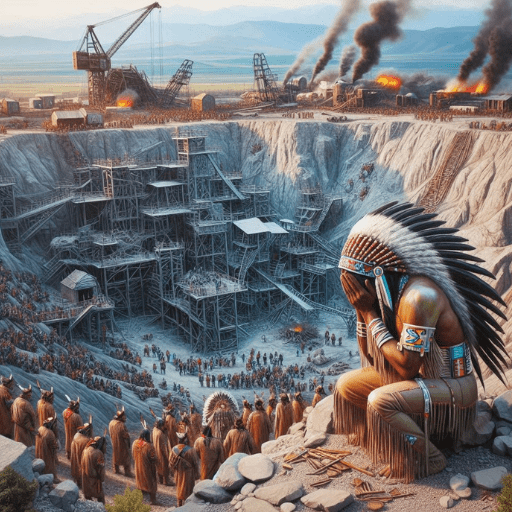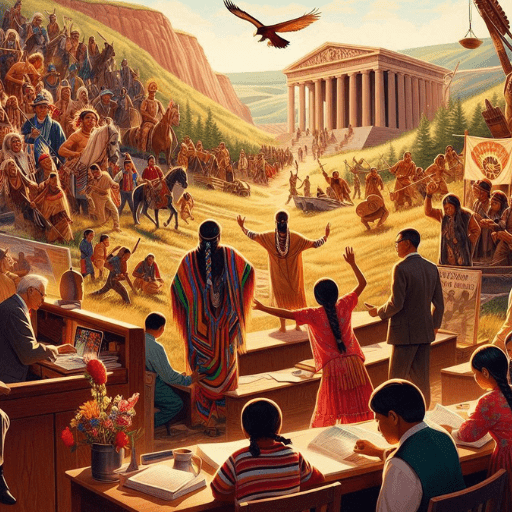Native American Tribes Displaced by the Gold Rush
The year 1848 marked a pivotal turning point, as the California Gold Rush drew settlers westward, forever altering the lives of The Forgotten Guardians, affecting over 150,000 Native Americans in the region. This wasn’t merely an event in history books; it was a devastating moment for Native communities, whose deep-rooted traditions, connection to the land, and way of life were directly impacted.
Key Takeaways:
The Rush That Changed Everything for the Forgotten Guardians
Native American tribes in California lived harmoniously with the land, guided by elders and a seasonal rhythm deeply tied to ceremonies that celebrated their connection to nature. The Gold Rush abruptly disrupted this way of life, as sacred sites were desecrated, lands overtaken, and resources depleted.
Government-Sanctioned Destruction
Government policies, such as the Indian Removal Act, further displaced Native communities, legitimizing the expansion that would strip them of land and identity. State actions allowed for aggressive settlement, accelerating the loss of both territory and cultural heritage.
Cultural Devastation of The Forgotten Guardians
Ceremonies and traditions that once reinforced community unity and identity were threatened, as tribes faced environmental damage and displacement. Sacred rituals tied to specific lands and seasons became impossible to uphold in the face of mining activities that devastated their natural surroundings.
Fighting Back and Moving Forward
Despite immense loss, Native tribes showed resilience, preserving what they could of their heritage. Today, they continue the fight for recognition, land rights, and the revival of cultural practices. Their struggle highlights both historical resilience and the ongoing pursuit of justice.
A History That Needs Telling
The legacy of the Gold Rush serves as a reminder of the historical injustices inflicted upon Native American communities and the enduring efforts to reclaim their stories. It’s a past that needs acknowledgment for a future of understanding and respect.
Introduction to the Forgotten Guardians
The glitter of gold forever changed California’s landscape, but beneath the famous tales of fortune and adventure lies a darker story. When James Marshall discovered gold at Sutter’s Mill in 1848, he unknowingly set events that would devastate the forgotten guardians in motion. These Native American tribes had called California home for thousands of years.
Before the Gold: A Land of The Forgotten Guardians

Before the first nugget was pulled from the American River, California buzzed with the vitality of diverse Native communities. The Miwok, Maidu, Yokut, Shasta, and Pomo tribes lived in harmony with the land, maintaining sophisticated societies that many newcomers failed to understand or appreciate.
These tribes didn’t just survive on the land—they thrived. The Miwok people developed complex agricultural systems, cultivating native plants and managing the forest through controlled burns. The Yokuts built extensive trade networks stretching from the coast to the Sierra Nevada. Fish-filled rivers, abundant game, and fertile valleys provided everything these communities needed.
The forgotten guardians’ connection to the land went far beyond mere survival. Sacred sites dotted the landscape, each one telling stories of their ancestors and spiritual beliefs. Children learned their tribes’ languages, stories, and traditions under the same oak trees their great-grandparents had gathered beneath. This way of life, sustained for countless generations, was about to face its greatest challenge.
The Rush That Changed Everything For The Forgotten Guardians

The news of gold spread like wildfire. By 1849, waves of fortune seekers crashed into California, bringing chaos to the organized societies of Native peoples. The numbers tell a stark story: in just a few years, over 300,000 people flooded into California. For perspective, that’s more than the entire Native American population of the region at the time.
The Miwok and Nisenan tribes of the Sacramento Valley were the first to witness their world turning upside down. Miners tore up riverbeds, poisoned water sources with mercury, and scared away game animals. The newcomers didn’t see the careful balance Native Americans had maintained with the environment—they saw only obstacles to their dreams of wealth.
Imagine watching your grocery store, pharmacy, and place of worship being destroyed all at once. This was the reality for Native peoples as miners stripped the land bare. Acorn-producing oak groves, a crucial food source, were cut down for timber. Salmon streams, once teeming with fish, became muddy, lifeless channels. The very foundation of tribal life began crumbling beneath their feet.
Government-Sanctioned Destruction

What followed wasn’t just displacement—it was systematic elimination. In 1851, California’s first governor, Peter H. Burnett, made a chilling declaration. He announced that a “war of extermination” would continue against Native Americans until they ceased to exist. This wasn’t just tough talk—it became official policy.
The state government paid militias to attack Native communities. Between 1851 and 1852 alone, California spent over $1 million (equivalent to millions today) funding these attacks. Militias raided villages, killed inhabitants, and forced survivors onto reservations in barren, unfamiliar territories far from their ancestral lands.
The federal government’s Indian Removal Act provided legal cover for these actions. Treaties were made and broken. Eighteen treaties were negotiated with California tribes in 1851-1852, promising 8.5 million acres for reservations. Congress never ratified these treaties, and the documents were hidden away for half a century.
Cultural Devastation Of The Forgotten Guardians

The damage went far beyond physical displacement. When tribes lost their lands, they lost the foundation of their cultural identity. Each mountain, river, and valley held stories, ceremonies, and meanings passed down through generations. These weren’t just places—they were the pages of their history books, the walls of their churches, the halls of their schools.
The Yokuts, once one of California’s largest tribal groups, saw their numbers plummet from tens of thousands to just a few thousand within decades. Disease, starvation, and violence took their toll. But equally devastating was the loss of their cultural practices. Children were forbidden to speak their native languages. Sacred ceremonies couldn’t be performed because holy sites were now mining camps or settlements.
Imagine trying to maintain your culture when every physical connection to your heritage has been stripped away. That’s what the forgotten guardians faced. Languages that had evolved over thousands of years fell silent. Traditional knowledge about plants, animals, and the natural world—knowledge that had sustained communities for generations—began to fade.
Fighting Back and Moving Forward

Despite overwhelming odds, the forgotten guardians of California’s Native American tribes refused to disappear. Some fought back directly, defending their lands against miners and militias. Others found ways to preserve their cultural heritage in secret, passing down stories and traditions behind closed doors.
In more recent times, tribes have turned to the courts to reclaim what was taken. Legal battles have helped some communities recover portions of their ancestral lands. The Miwok people, for instance, have successfully regained control of several sacred sites. These victories, though small compared to what was lost, represent important steps toward healing historical wounds.
Modern Native American communities continue fighting to protect what remains of their heritage. The 1988 Lyng v. Northwest Indian Cemetery Protective Association case highlighted the ongoing struggle to preserve sacred lands from development. While the tribes lost that particular battle, it drew attention to their continuing fight for cultural survival.
A History That Needs Telling
The California Gold Rush appears in history books as a triumphant chapter in American expansion. Textbooks celebrate the pioneers who “built” California, often overlooking the sophisticated societies they destroyed in the process.
This oversight isn’t just about the past. Today’s Native American communities still feel the effects of Gold Rush policies. Many tribes remain unrecognized by the federal government. Sacred sites continue to face threats from development. The wealth extracted from California’s hills came at a price that Native peoples are still paying.
Understanding this history helps us recognize the true cost of the Gold Rush. Behind the famous tales of overnight millionaires and boom towns lies the story of California’s first peoples—communities that lost nearly everything to the quest for gold. Their story reminds us that history’s greatest transformations often come with hidden costs, and that the impacts of the past continue to shape our present.
The legacy of the Gold Rush isn’t just in the museums and ghost towns that draw tourists today. It lives on in Native American communities working to preserve their languages, reclaim their lands, and maintain their cultural traditions against seemingly impossible odds. Their resilience offers perhaps the most valuable lesson of all: that even in the face of tremendous loss, the human spirit can endure, adapt, and continue fighting for justice.
Read Counterarguments
FAQs:
How did the Gold Rush affect Native American tribes?
The Gold Rush led to the displacement, cultural suppression, and even genocide of many Native American tribes in California. Miners and settlers took over their lands, disrupted their way of life, and introduced diseases that decimated their populations.
What role did the government play in the displacement of Native Americans?
Both the state and federal governments actively participated in the displacement of Native Americans. The California government funded militias to attack Native communities, while the federal government’s Indian Removal Act provided legal cover for these actions.
How did the loss of land impact Native American culture?
The loss of land was devastating for Native American culture. Sacred sites were destroyed, languages were forbidden, and traditional knowledge began to fade. This led to a profound loss of cultural identity for many tribes.
How did Native Americans resist and fight back?
Native Americans resisted in various ways, including direct fighting, preserving cultural traditions in secret, and pursuing legal action to reclaim ancestral lands.
Why is it important to remember this history?
Remembering this history is crucial for understanding the true cost of the Gold Rush and recognizing its ongoing impact on Native American communities today. It also highlights the resilience of Native peoples in the face of immense adversity.








2 Comments